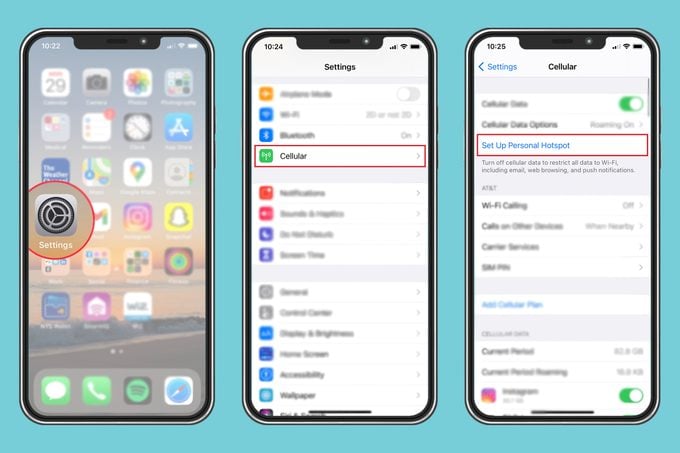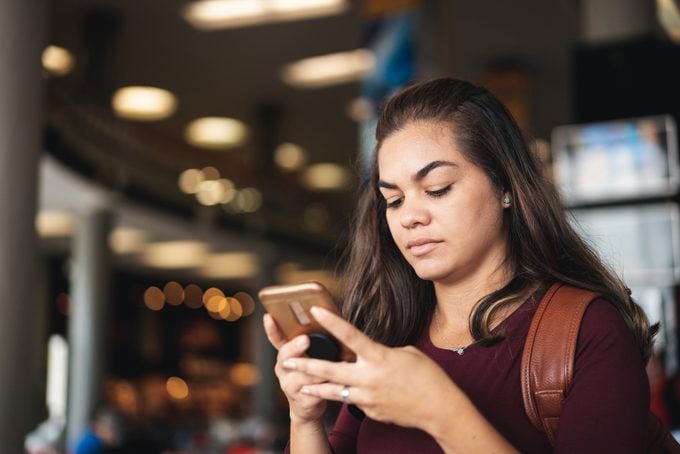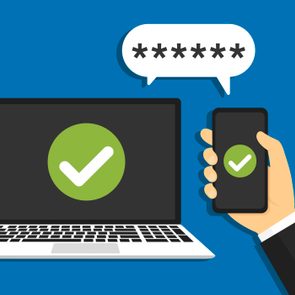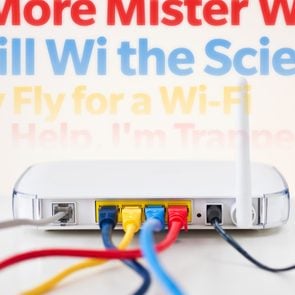How to Get Free Wi-Fi Wherever You Go
Updated: Jan. 25, 2024

Figuring out how to get free Wi-Fi when you're on the go isn't always easy. This step-by-step guide can help.
Children of the ’90s likely remember the agony of those early dial-up Internet years. The waiting. The connecting. The tone that told them they were almost there. The wires. So many wires. Today, connecting to the Internet can happen in a matter of seconds. And though we might still wonder what Wi-Fi stands for, we know without a doubt that Wi-Fi requires no cords. Additionally, wireless Internet connection usually comes at a cost—unless you follow this expert advice on how to get free Wi-Fi.
Afterwards, check out these things you shouldn’t do on a public Wi-Fi network, and hidden reasons your Internet is so slow.
1. Create a mobile hotspot

“If your phone has a mobile data connection available, you can use it as a Wi-Fi hotspot and let other devices connect to it to access the Internet just like they would with a normal router,” says Patrick Sinclair, founder and tech blogger at All Home Robotics.
This is just about the easiest Wi-Fi you could hope to access, he says. And while it isn’t necessarily free (you are paying for the data plan, after all), it is a source that is already available to you.
To use your phone as a hotspot, open Settings and then click on Cellular. At the top, you’ll see a Set Up Personal Hotspot option. Clicking it will get you started. “Set a password and turn it on,” Sinclair says. “Then you can connect to the hotspot from other devices as normal.” Just make sure you don’t use one of the passwords hackers often guess.
Making your device a hotspot could still open you up to unwanted guests, however. You may want to keep an eye out for these signs that someone is stealing your Wi-Fi.
2. Check city websites
Cathy Mills, director of strategy for Net Influencer, is often on the hunt for her own Wi-Fi connections while traveling. “An excellent tip to get free Wi-Fi wherever you are is to check the official websites of the places you are going to visit,” she says. According to Mills, many cities offer free Wi-Fi to people passing through town, whether for business or pleasure.
“All you have to do is register to have your own username before you log in,” she explains. “On these websites, you will also find information about tourist sites and restaurants.”
Those information pages can also point you toward other places around town where you might be able to get free Wi-Fi.
3. Connect at common establishments

As an SEO consultant, Daniel Foley has had to hunt down his own free Wi-Fi a time or two. He says that while using your device as a hotspot is usually convenient, you can also look for open hotspots to connect to if you want a truly free experience.
“Many hotels, coffee shops, and gas stations will let you use their Wi-Fi networks without having to pay for data,” he explains. These locations will often give access to paying customers for free, although they may try to charge you if you aren’t already using their services.
4. Use a Wi-Fi map app
Let’s say you’ve been looking for one of those free Wi-Fi connections, but you haven’t had much luck. “Using a Wi-Fi map has been of huge help to me,” says Sally Stevens, cofounder of Fast People Search. “You can always find a free Wi-Fi connection if you have an app that provides a database of free Wi-Fi connections within the area.”
Whether you’re using an Apple or Android device, there are plenty of Wi-Fi map apps to choose from. In fact, the WiFi Map app is available on all devices. (Using iOS? These iPhone tricks will make your life so much easier.)
Is there an app for free Wi-Fi?
If your standard Wi-Fi map apps aren’t providing much, don’t lose hope. Free Wi-Fi is still within reach. “Instabridge and Wefi are two apps that let you identify networks that aren’t well-known,” Foley says. These apps can lead you to the free Wi-Fi hotspots you might not otherwise find—or the ones that others aren’t already flocking to.
5. Connect at unexpected locations
Sometimes all your tricks just run dry, which is when you have to get creative. “There are a few additional popular locales with clandestine networks,” Foley explains. “Because companies need to display merchandise, most electronic stores, for example, supply Wi-Fi.”
Sometimes it’s just a matter of thinking outside the box, he says. If you’re in an airport and you’re unable to connect to their Wi-Fi, for example, he suggests moving closer to the luxury lounges to see if you can connect to anything there.
6. Don’t be afraid to ask
In all this searching, we’ve left out the most basic solution for how to get free Wi-Fi: Ask. “I can’t tell you how many times I’ve gone into a business and simply asked for the Wi-Fi password and received it, even if they don’t advertise that they have it,” says Imgkits CEO and tech expert Robert Johansson.
And in the event you can’t connect to a company’s Wi-Fi? He says you should move on to asking a stranger if you can connect to their hotspot. Yes, really. “People aren’t always that frugal with their Wi-Fi, believe it or not,” Johansson says.
If all else fails, you can prepare ahead of time by asking people on the Internet. Foursquare and Facebook can help you figure out which airports offer free Wi-Fi, Johansson explains. In other words: The kindness of strangers may prove to be your most valuable tool for finding free Wi-Fi.
How to stay safe on public Wi-Fi

Of course, no matter what your solution is for how to get free Wi-Fi, you want to make sure you’re protecting yourself—and your devices, passwords, and accounts. Because the answer to the question “Are open Wi-Fi networks safe?” is no, not really.
Here is why you should think twice before connecting to the Hotel Wi-Fi on your next vacation.
Monica Eaton, COO of the fintech company Chargebacks911, says that while there are several ways to access Wi-Fi without paying for it, users still need to be smart about the risks they are exposing themselves to. “If you need to look at something online immediately—like a map, or your hotel’s street address—then free Wi-Fi can be a lifesaver. But beware: Wi-Fi that’s open to you is open to others as well.”
If you’re sending or receiving sensitive information (think: financial data, or personal passwords), the network you’re connecting to may be vulnerable to cybercriminals. “Just because something is free doesn’t mean it’s safe,” Eaton explains. Here’s what hackers can do with just your phone number.
She suggests a few simple steps to give yourself an added layer of protection:
- Try to stick to websites that start with https instead of http. The S in the URL denotes a higher level of encryption.
- Make sure you’re logging into the right Wi-Fi—the official one from the library or restaurant—and not just a random Wi-Fi network that could have been created by a hacker.
- Don’t transmit your password, credit card data, or other private info. Wait until you’re on a secure connection before you make online purchases.
She further suggests setting up a fake email account specifically for times when you need to use public networks, as this can help create some separation between you and any potential fraud threats.
And whenever possible, using a VPN is one of the best options you’ve got for keeping your information safe and secure while online.
Sources:
- Patrick Sinclair, founder and tech blogger at All Home Robotics
- Cathy Mills, director of strategy for Net Influencer
- Daniel Foley, SEO consultant and founder of Daniel Foley SEO
- Sally Stevens, cofounder of Fast People Search
- Robert Johansson, tech expert and CEO of Imgkits
- Monica Eaton, owner, cofounder, and COO of Chargebacks911






















